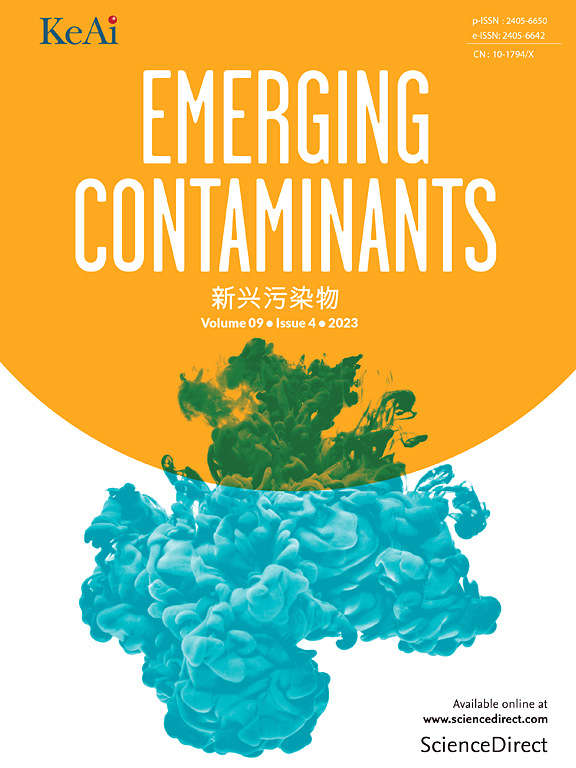原生产基地全氟辛烷磺酸的初步风险评估:以中国湖北为例
IF 6.9
2区 环境科学与生态学
Q1 ENVIRONMENTAL SCIENCES
引用次数: 0
摘要
对受污染场址,特别是可能受到严重污染的前制造场址进行健全的管理,对于缔约方执行《关于持久性有机污染物的斯德哥尔摩公约》至关重要。不幸的是,发展中国家许多以前的生产场所没有得到充分调查,特别是那些与新列入持久性有机污染物清单的场所,如全氟辛烷磺酸(PFOS)。继3M于2002年自愿淘汰全氟辛烷磺酸之后,中国成为全氟辛烷磺酸的主要生产国,并于2021年停产。然而,关于这些原全氟辛烷磺酸生产基地的污染水平的信息很少。本研究的重点是位于中国湖北的五个特定地点。收集现场和非现场的土壤和地下水样本进行全氟辛烷磺酸分析。现场土壤、非现场土壤和地下水样品的浓度分别为392 ~ 7.78 × 105 μg/kg、5.05 ~ 83.2 μg/kg和84.1 ~ 1.74 × 103 μg/L。采用中国现行国家标准(即GB 36600-2018和HJ 25.3-2019),建立全氟辛烷磺酸筛选和管理水平,进行风险评估。初步风险评估表明,当使用两个不同的全氟辛烷磺酸特征数据库进行评估时,34%和100%的采样点将构成不可接受的风险。研究结果强调了全氟辛烷磺酸在原生产基地造成的重大健康风险,以及迫切需要进行监管干预。本文章由计算机程序翻译,如有差异,请以英文原文为准。

Preliminary risk assessment of PFOS in former production sites: A case study in Hubei, China
Sound management of contaminated sites, particularly former manufacturing sites with potential heavy contamination, is crucial for the Parties to implement the Stockholm Convention on Persistent Organic Pollutants (POPs). Unfortunately, numerous former manufacturing sites in developing countries have not been well investigated, especially for those associated with newly listed POPs such as perfluorooctane sulfonate (PFOS). Following 3M's voluntary phase-out plan in 2002, China emerged as the primary producer of PFOS and ceased production in 2021. However, little information is available about the contamination levels at these former PFOS production sites. This study focused on five specific sites located in Hubei, China. Soil and groundwater samples, both on-site and off-site, were collected for PFOS analysis. Concentrations ranging from 392 μg/kg to 7.78 × 105 μg/kg in on-site soil, 5.05 μg/kg to 83.2 μg/kg in off-site soil, and 84.1 μg/L to 1.74 × 103 μg/L in groundwater samples were found, respectively. By employing current national standards in China (i.e. GB 36600-2018 and HJ 25.3–2019), PFOS screening and management levels were established for risk assessment purposes. Preliminary risk assessments showed that 34 % and 100 % of the sampling points would pose unacceptable risks when evaluated using two distinct PFOS characteristic databases. The results highlight the significant health risk caused by PFOS at former production sites as well as the urgent need for regulatory interventions.
求助全文
通过发布文献求助,成功后即可免费获取论文全文。
去求助
来源期刊

Emerging Contaminants
Medicine-Public Health, Environmental and Occupational Health
CiteScore
10.00
自引率
6.70%
发文量
35
审稿时长
44 days
期刊介绍:
Emerging Contaminants is an outlet for world-leading research addressing problems associated with environmental contamination caused by emerging contaminants and their solutions. Emerging contaminants are defined as chemicals that are not currently (or have been only recently) regulated and about which there exist concerns regarding their impact on human or ecological health. Examples of emerging contaminants include disinfection by-products, pharmaceutical and personal care products, persistent organic chemicals, and mercury etc. as well as their degradation products. We encourage papers addressing science that facilitates greater understanding of the nature, extent, and impacts of the presence of emerging contaminants in the environment; technology that exploits original principles to reduce and control their environmental presence; as well as the development, implementation and efficacy of national and international policies to protect human health and the environment from emerging contaminants.
 求助内容:
求助内容: 应助结果提醒方式:
应助结果提醒方式:


